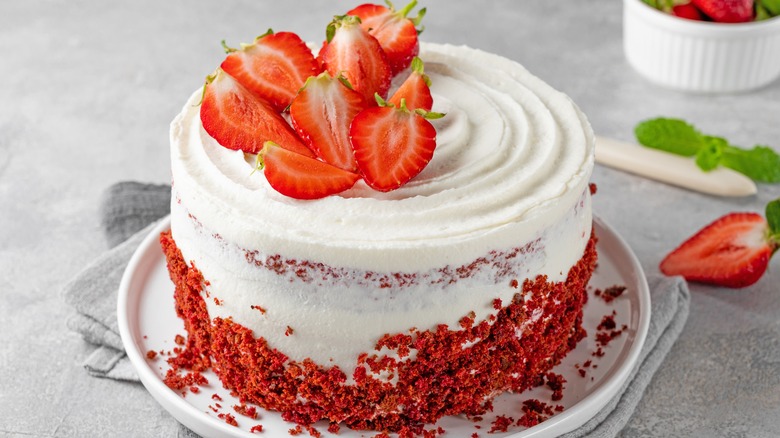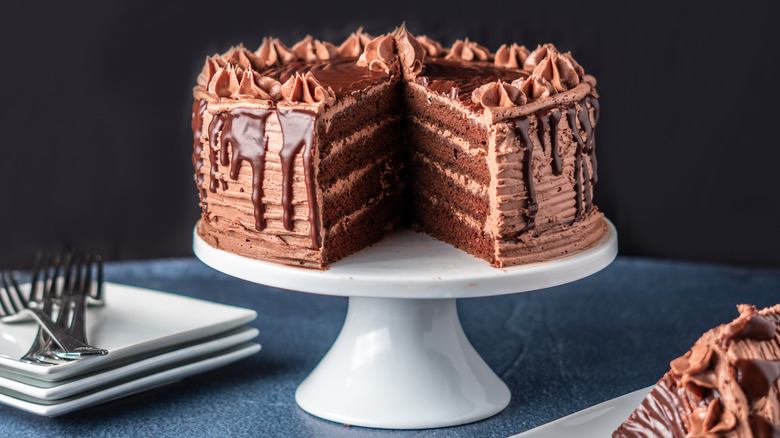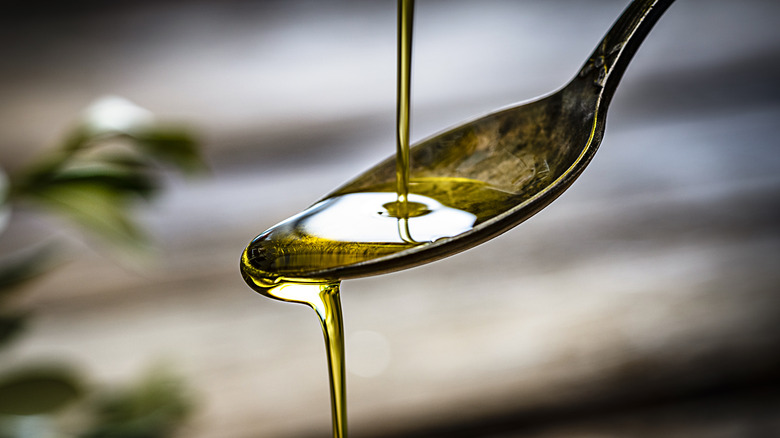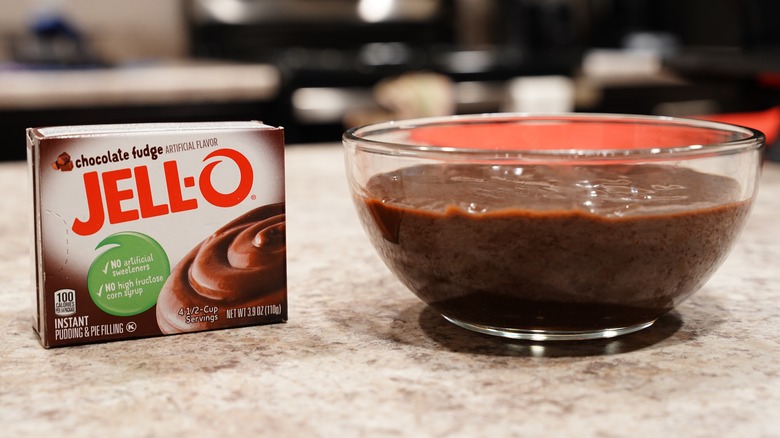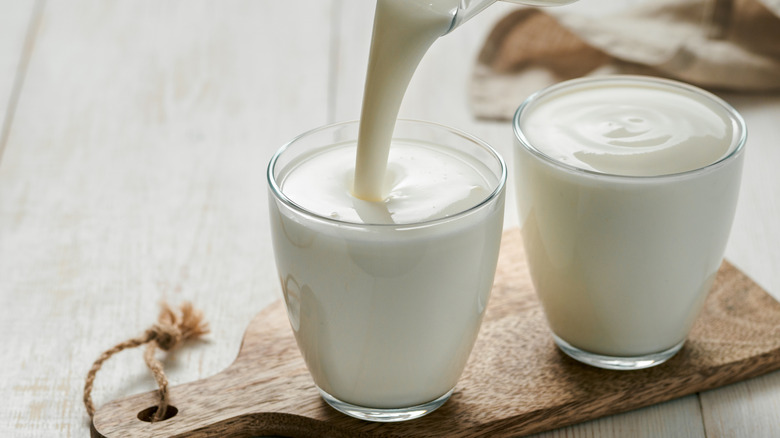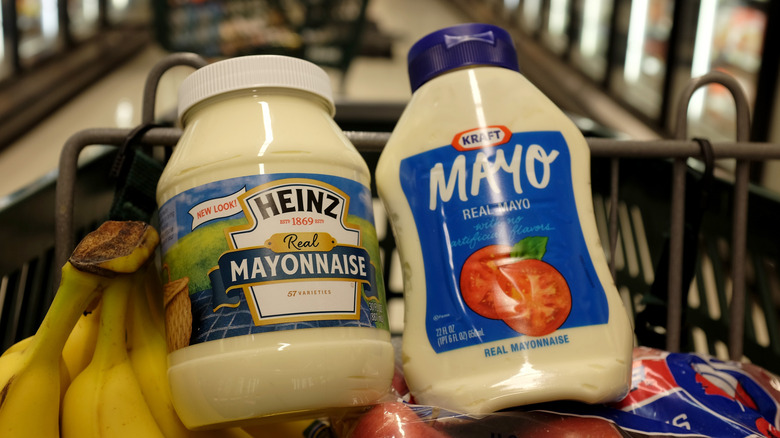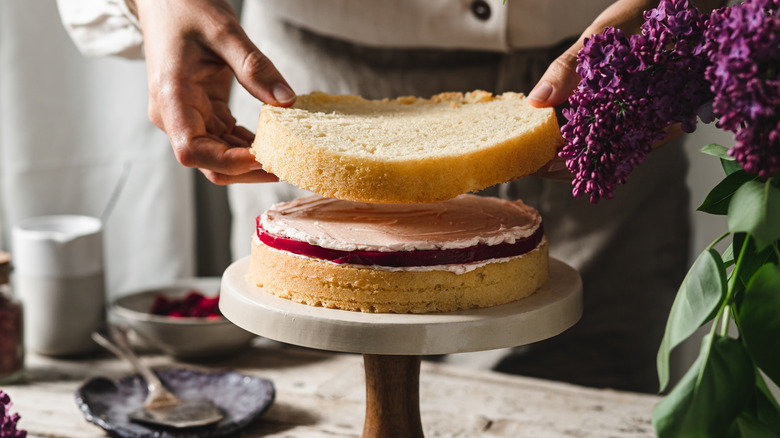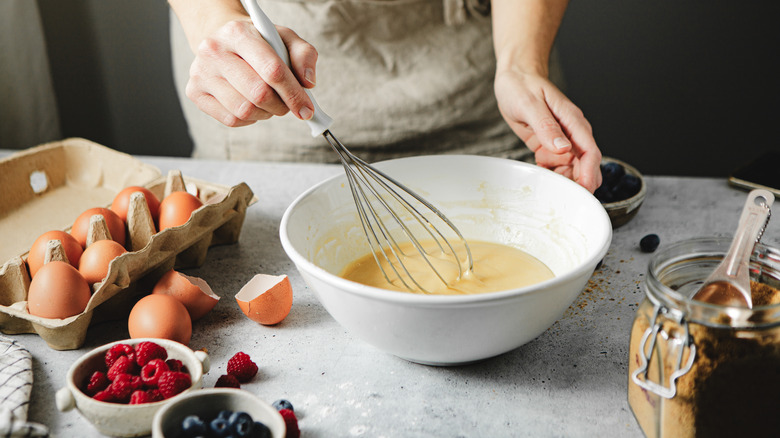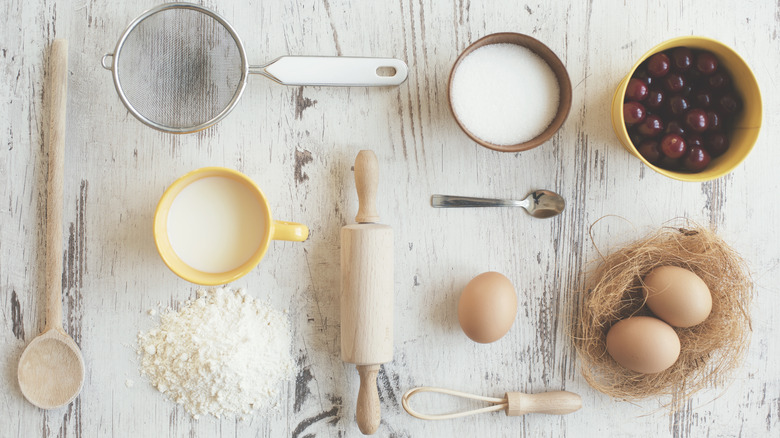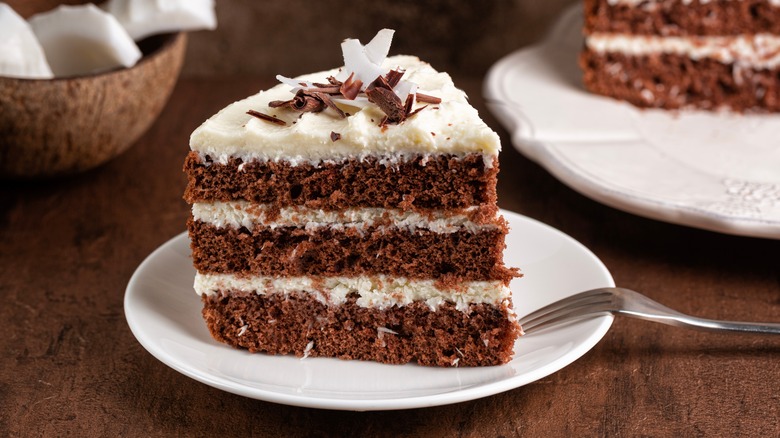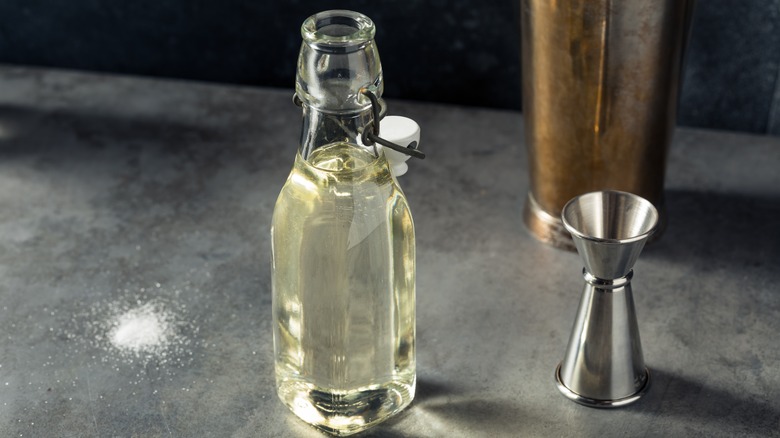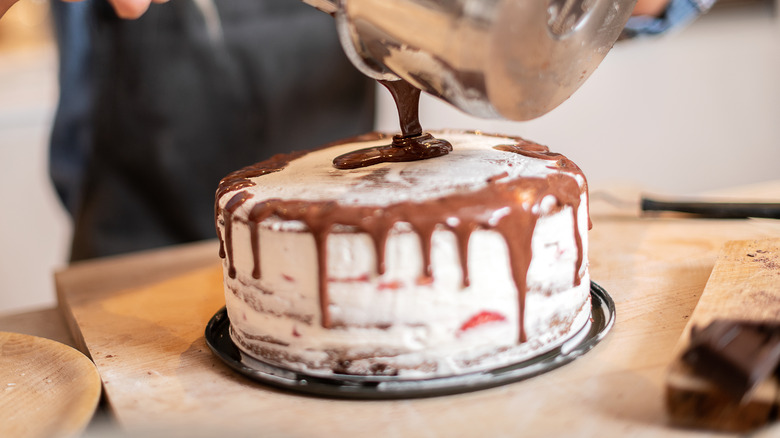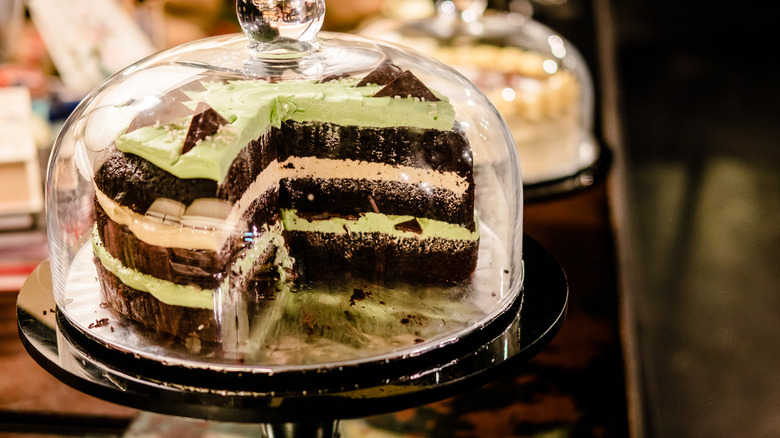12 Hacks For An Incredibly Moist Cake
Close your eyes and imagine the best cake you've ever tasted. It may have been fancy or plain, light and airy, or sturdy and dense, but whatever your favorite cake may have been, it almost certainly had a tender, moist crumb. While people's flavor and style preferences for cake may differ, nobody likes a dry cake.
Many home bakers, however, struggle to produce consistently moist and tender cakes. This is understandable, since most of us probably don't bake all that often. When we do, though, it's almost always for a special occasion, and the last thing we want is to ruin the celebration with a dry, boring cake. To help you make celebration-worthy treats every time, here are some hacks used by bakers and food service professionals that keep their cakes tender and scrumptious — give one of them a try and watch your next cake become your guests' new favorite.
Watch your temperature and baking time
An obvious culprit of any kind of dry baked good is over-baking. Heat makes the water in cake batter evaporate, which is how a pan of liquid batter transforms into a sliceable cake. But heat that's too intense — or exposure that's too prolonged — can suck out so much moisture that your cake ends up tasting like sawdust.
To prevent this, pay close attention to your oven temperature and cooking time. Use a thermometer to ensure your oven is actually at the temperature you want — it's common for home ovens to run either hotter or cooler than their temperature gauges indicate. Check your cake frequently once you draw near the prescribed baking time to ensure you don't let it over-bake. Some chefs tend to over-bake their cakes because they dread the prospect of an underbaked dessert, but remember, you can always return an under-baked cake to the oven. The only way to fix an over-baked cake is to repurpose it in a cake pop recipe.
Use oil for a moist crumb
Another factor that can impact the moisture of your cake is your choice of fat. Butter does lend richness and flavor, but if a moist cake is your priority, aim for recipes that use vegetable oil instead. Because oil, unlike butter, stays liquid even when cold, it helps cakes stay tender and moist at room temperature (or even straight out of the refrigerator). Cakes that typically use oil rather than butter include carrot cakes and chiffon cakes.
So, can you take your favorite butter-based cake recipe and simply swap out the butter for oil? Sometimes. If that butter flavor is front and center in your recipe — such as in traditional pound cakes — the answer is a hard no. Oil substitution is also a no-go for cake recipes that ask you to cream the butter and sugar together before whipping in eggs; since creaming incorporates air into the cake to give it lightness and lift, stirring in oil instead would result in a flat, dense cake. For cases in which a swap is possible, remember that butter is 80% fat and 20% water and milk solids, while oil is 100% fat. So, to make a successful swap, use a quantity of oil equal to 80% of the weight of the butter, and use milk for the rest of the weight. For example, if a recipe calls for 10 ounces of butter, use 8 ounces (in weight) of oil and 2 ounces of milk.
Instant pudding mix adds flavor and moisture
It's no accident that so many of home cooks' favorite cake recipes include instant pudding mix. Not only does this mix add a powerful hit of flavor and richness, it also helps keep cakes moist, even after several days in the refrigerator. This is because one of its main ingredients, modified corn starch, is a moisture magnet — it traps and binds water from the cake's other ingredients, forming a gel-like consistency. This gives the cake a tender, creamy mouthfeel and slows staling and drying once the cake is baked.
If you want the luscious mouthfeel of a pudding-charged cake but not the added flavoring, you have another option at your disposal. Commercial bakers use plain modified cornstarch (sold as Instant Clearjel) specifically for this purpose. This flavorless powder, available online, offers the same moisture-boosting qualities as instant pudding mix but allows your favorite recipe's flavor profile to shine. To achieve the best results, substitute modified cornstarch for 10% of the weight of the flour in your recipe.
Buttermilk ensures an extra tender crumb
One secret for ensuring a moist cake is to start with the right recipe, as some will produce moister cakes than others. One way to tell if a recipe is likely to be a winner is to look for ingredients that promote moisture and tenderness, such as instant pudding mix and vegetable oil. Another ingredient that will ensure an extra-tender cake is buttermilk.
Buttermilk works its magic because it's more acidic than regular milk, and this acid helps break down the flour's gluten, thus making cakes softer and more tender. As a bonus, its natural tanginess also balances the cake's sweetness, lending it a deeper flavor. If you have a cake recipe you like that calls for regular milk, you can use buttermilk instead, but it won't be a direct swap. Because buttermilk interacts with leaveners like baking soda differently than regular milk does, you'll have to adjust the quantity of your leaveners, too — for every cup of buttermilk you use, reduce the amount of baking powder in the recipe by 2 teaspoons and increase the amount of baking soda by ½ teaspoon.
Make mayonnaise your secret weapon
Collectors of vintage cookbooks love to marvel at Depression-era cake recipes that feature such unlikely ingredients as canned tomato soup or sauerkraut. While we can simply consider these interesting historical curiosities, one oddball ingredient from that era has stood the test of time: mayonnaise. Yes, you can put it in cake, and no, it won't make your cake taste of mayo — but it will make your cake exceptionally moist.
Mayonnaise contributes tenderness because of its ingredients: It's basically an emulsion of eggs, oil, and acidic flavorings like vinegar or lemon juice, and both oil and acid make cakes moister and more tender. It's also easy to incorporate into a cake: Some cooks suggest simply adding a dollop to whatever recipe you're using. If you're making cake from a boxed mix, adding mayo is an easy way to elevate it: Simply use mayo in place of the oil the box calls for. Because mayonnaise contains eggs, some cooks take this incorporation a step further and reduce the number of eggs in their cakes when they use it.
Use cake flour, not all-purpose flour
It makes logical sense that something called cake flour would be especially well-suited to making cakes. This flour differs from standard all-purpose flour in that it's more finely ground and has a lower gluten content. This is because it's made with soft wheat that has a relatively low protein content, meaning it will help create cakes with a moister, more delicate, and more tender crumb. Cake flour also adds lightness to cakes; for instance, an angel food cake made with cake flour will rise higher than one made with all-purpose flour.
So, if you want a moist, super-tender cake, look for recipes that call for cake flour. If you don't have any on hand (and don't bake often enough to justify buying a whole package), you can make a workable substitute by mixing 2 tablespoons of cornstarch into ¾ cup plus 2 tablespoons of all-purpose flour. That said, while you can use all-purpose flour in recipes that call for cake flour and still get acceptable (if slightly denser) bakes, the reverse isn't true. If you use cake flour in a recipe that calls for all-purpose, you can end up with cakes that sink or that are too delicate to hold together when sliced.
Avoid overmixing
Gluten — a protein found in wheat — is an essential component in bread, but while it lends loaves their characteristic bounciness and chew, it's not always a welcome ingredient in cakes. Too much gluten can cause cakes to become tough and dry rather than moist and tender. For this reason, many cake recipes include ingredients such as buttermilk, which suppresses gluten's development, or the aforementioned cake flour, which contains less gluten than the all-purpose variety.
All that said, the simplest way to prevent gluten from toughening your cake, regardless of the recipe you use, is to avoid over-stirring your batter. If you've ever noticed that a cake recipe specifies that you mix in flour just until blended — and even specifies that some visible flour streaks are okay — this is why. Think of this as the exact opposite of what you do when making bread, in which you knead the dough aggressively to help develop the gluten and make the dough strong and elastic. For cake, you want to avoid building up gluten, so you'll want to handle the flour as little as possible.
Bring all ingredients to room temperature before mixing
We've all seen cake recipes that specifically call for room-temperature ingredients like butter, eggs, and milk. Being time-pressed and hungry, most of us have ignored them at least once. Waiting an hour or two for cake is hard enough, so why wait another hour for the eggs and butter to reach room temperature? Does it really make any difference?
While you can still get a sort-of-okay cake with cold ingredients, if you want to ensure your cake is light, moist, and tender, this extra step is absolutely worth it, especially if your recipe calls for creaming the butter and sugar together or whipping up egg whites to give your cake volume. Creaming helps lighten cakes because the sugar crystals cut into the soft butter and generate tiny air pockets — a process that can only occur if the butter is warm and soft enough to combine properly with the sugar.
Similarly, eggs are more elastic at room temperature than when cold, so they'll form fluffier foam when beaten. Moreover, because room-temperature ingredients combine more easily, you'll avoid over-mixing, a frequent cause of tough, dry cakes. If you're in a hurry, you can soften a still-wrapped stick of butter in the microwave on high for 8 seconds, flip the stick over, then zap it for 8 seconds more. To bring refrigerated eggs to room temperature quickly, put them in a bowl of warm water for 10 to 20 minutes.
Bake cake layers on a baking sheet
If you're a frequent home baker, you've probably noticed that the edges of round cakes (and the corners of rectangular ones) are often browner, crunchier, and a bit drier than their centers. For some of us, these crispy bits are the best part of a cake, but for those who crave a consistently moist and tender bite, they seem like a design flaw. Some bakers even cut off the browned crusts from their cakes before icing and serving them to ensure a uniform texture and color throughout.
An even easier way to avoid a dark crust and dry zones in your cake is a trick often used by pro bakers: Instead of baking cakes in standard round or square cake pans, bake thinner layers in rimmed baking sheets and use cake rings to cut the layers to your desired size. This method not only helps your cakes bake faster, it also ensures moist, crust-free layers of uniform thickness. As an extra bonus, it also spares you the onerous task of trying to split your cake into even layers.
Brush your cake with simple syrup
Once your cake is out of the oven, you can take additional steps to enhance its moisture content and prevent it from drying out. An easy trick for locking in moisture is to brush a just-baked cake with simple syrup. The hot-from-the-oven cake will absorb the syrup, which will enhance the cake's flavor and texture while helping to lock in moisture. About ½ cup of syrup will be enough for a standard-size cake — you want to use just enough to ensure your cake is moist, not soggy.
Simple syrup is quick and simple to make, and you can easily whip up a batch while your cake is baking: Just combine equal volumes of sugar and water in a saucepan, bring the mixture to a boil, and simmer for a couple of minutes. If you want to enhance the flavor of your cake even more, you can flavor your syrup with ingredients like vanilla extract, lemon juice, rum, or coffee — use whichever flavor best complements your cake. Here's another tip: If you have leftover syrup, it lasts indefinitely in the refrigerator and is a useful ingredient for cocktails.
Ice your cake immediately after it cools
While an unadorned slice of homemade poundcake or gingerbread can be a delightful treat, we all know that icing elevates cakes from snack-food fare to celebration-centerpiece material. Not only does icing add visual appeal and a welcome flavor and textural contrast to a cake, but it can also serve another useful purpose by keeping the cake moist. Besides contributing moisture itself, a layer of icing also keeps the cake's own moisture locked in, thus keeping the dessert fresh longer.
To ensure your cake retains as much moisture as possible, ice it as soon as it cools to room temperature. If your schedule requires you to bake one day and assemble and ice your cake on another, securely wrap and freeze your cake layers to keep them fresh until you can ice them; however, don't attempt to ice your cake while it's still warm — not only are warm cakes more delicate and prone to crumbling and cracking, but the heat can make your icing slip, drip, or melt.
Store your cake carefully to preserve moisture
Once you've baked a perfectly moist cake and given it a protective finishing touch of syrup or frosting, your next task is to keep it as fresh as possible until the time comes to serve. If your kitchen is fairly cool — i.e., below 75 degrees Fahrenheit — and you only need to save your cake a day or two before serving, your best option is to keep it tightly covered at room temperature. While this may sound counterintuitive, the kitchen counter is a better option than your refrigerator, as the latter can dry out and harden a fresh cake. (That said, if your cake includes highly perishable components — like our recipe for sponge cake with fresh berries and mascarpone — or if your kitchen runs hot, the refrigerator is a safer option).
A good way to keep leftover cake moist is to cover any exposed slices with extra icing. An airtight container can help protect your cake from the elements, but you should keep it open a crack, as a bit of airflow will help preserve the cake's texture. For longer-term storage, wrap your cake securely in plastic, then foil, and freeze it. Frozen cakes can generally stay fresh for up to three months.

